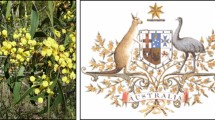Abstract
ALTHOUGH quercetin ((Fig. 1), R = R′ = H) itself frequently occurs in the leaves and flowers of higher plants, its simple mono and dimethyl ethers (apart from isorhamnetin, the 3′-methyl ether) have very rarely been reported. Azaleatin, the 5-methyl ether ((Fig. 1), R′ = Me, R = H), for example, was first isolated from the flowers of Rhododendron mucronatum in 1956 (ref. 1) and has since been recorded in forty-four other Rhododendron species, in Plumbago capensis, in Ceratostigma willmottiana2 and in Carya pecan3. Caryatin, the 3,5-dimethyl ether ((Fig. l),R = R′ = Me), has only been found once4 in the bark of the latter plant, together with azaleatin. We now wish to record the occurrence and distribution of both these rare quercetin methyl ethers in the leaves of species of Eucryphia (Eucryphiaceae).
Similar content being viewed by others
References
Wada, E., J. Amer. Chem. Soc., 78, 4725 (1956).
Harborne, J. B., Arch. Biochem. Biophys., 96, 171 (1962).
Sasaki, T., and Mikami, M., Yakugaku Zasshi, 83, 897 (1963).
Sasaki, T., Yakugaku Zasshi, 84, 195 (1964).
Bate-Smith, E. C., J. Linn. Soc. (Bot.), 58, 95 (1962).
Author information
Authors and Affiliations
Rights and permissions
About this article
Cite this article
BATE-SMITH, E., HARBORNE, J. & DAVENPORT, S. Occurrence of Azaleatin and Caryatin in Eucryphia. Nature 212, 1065–1066 (1966). https://doi.org/10.1038/2121065a0
Issue Date:
DOI: https://doi.org/10.1038/2121065a0
- Springer Nature Limited





